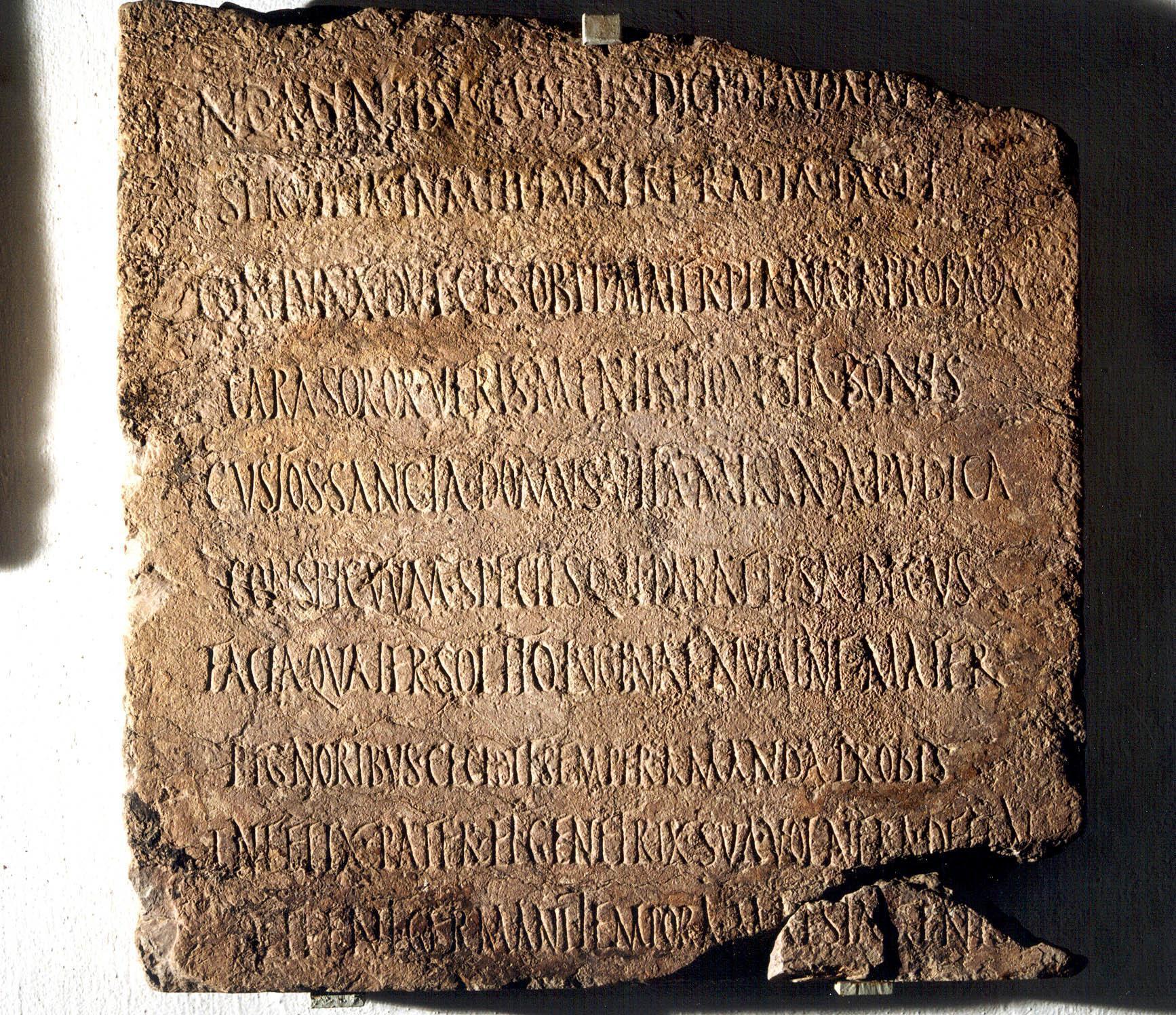Epitaph of Servilia
Reference CIL II2 / 7,540 | Description | Lyrics | Location | Chronology | Epigraphic edition | Translation | Apparatus | Comentary | Type of verse | Text divided into verses and metric signs | Images | Bibliography | Link to DB | Author |
Epitaph of Servilia
Description
- Idno filename 22/01/0081
- Type of inscription: Sepulcralis
- Material Description: Tablet of burgundy-pink limestone.
- Conservation status: Broken off at the bottom right corner, but without hampering the reading of the last two lines of text. Another break, on the upper right, affects the last two words of l.
- Dimensions height/width/depth (cm): 64/61.5/7
-
Epigraphic field:
- Layout: The layout is good, always respecting the breaks between verses and with regular indenting of the pentameters. Triangular interpunction, except at the beginning and end of a line.
- Preserved
Lyrics
- Font:Libraria
- Letter size:2,2/3,8 cm
- Description of the letters:In l. 9, the possible ligature <LE> in deflent cannot be seen because of the break.
Location
- Place of discovery: From the neighbourhood of El Zumbacón, in the area of El Marrubial (Córdoba)
- Geolocation
- Conservation location: M.A.P. of Córdoba, room III, inv. no. 24570.
- Inventory number: 24570
- Location with Modern Nomenclature España / Córdoba / From the neighbourhood of El Zumbacón, in the area of El Marrubial.
- Location with Old Nomenclature Hispania / Baetica / Cordubensis / Corduba
Chronology
- Inscription's dating: Between year 50 and year 130
- Dating explanation: In view of the shape of the letters, according to STYLOW, II2/7, 1st c. or beginning of the 2nd c.
Type of verse
- Type of verse: Dactílico (dístico elegíaco)
- Verse/line correspondence: Si
- Prose/verse distinction: No
Epigraphic edition
Nominibus ▴ cunctis ▴ digno ▴ laudata ▴ p̣uḍ[ore]
Servilia ▴ inmiti ▴ funere ▴ rapta ▴ iacet
coniunx ▴ dulcis ▴ obit ▴ mater ▴ pia ▴ nata ▴ probanda
cara ▴ soror ▴ veris ▴ mentis ▴ honesta ▴ bonis
5 custos ▴ sancta ▴ domus ▴ vita ▴ miranda ▴ pudica
conspicuum ▴ species ▴ qu(a)˹e˺ ▴ parat ▴ ipsa ▴ decus{s}
facta ▴ quater ▴ solito ▴ Lucinae ▴ numine ▴ mater
pignoribus ▴ cecidit ▴ semper ▴ amanda ▴ probis
infelix ▴ pater ▴ et ▴ genetrix ▴ sua ▴ volnera (!) ▴ deflent
10 deflent ▴ germani ▴ tempora ▴ maesta ▴ genis
Text divided into verses and metric signs
Nominibus cunctis digno laudata pud[ore], lkk|l/l|l/l|l/l|lkk|[l~]
Servilia, inmiti funere rapta, iacet. lkk|ll|l||lkk|lkk|~
coniunx dulcis obit, mater pia, nata probanda, ll|lkk|l/l|l/kk|lkk|l~
cara soror, veris mentis honesta bonis. lkk|ll|l||lkk|lkk|~
5 custos sancta domus, vita miranda, pudica, ll|lkk|l/l|l/l|lkk|l~
conspicuum species quae parat ipsa decus lkk|lkk|l||lkk|lkk|~
facta quater solito Lucinae numine mater, lkk|l/kk|l/l|ll|lkk|l~
pignoribus cecidit semper amanda probis. lkk|lkk|l||lkk|lkk|~
infelix pater et genetrix sua volnera deflent, ll|l/kk|l/kk|l/kk|lkk|l~
10 deflent germani tempora maesta genis. ll|ll|l||lkk|lkk|~
Translation
“Praised for a modesty worthy of all her titles, here lies Seruilia, snatched away by an early death: a dear wife has died, an affectionate mother, a praiseworthy daughter, a beloved sister, noble in the authentic goodness of her heart. Irreproachable guardian of her house, deserving of praise for her virtuous life, her very beauty secures her great honour. Four times a mother under the wonted protection of Lucina, she died meriting for ever the love of her dear children. Her unfortunate father and her mother weep over their wounds, her brothers weep with tears on their cheeks at this sad time.”
Bibliography
Mariner 1983, 98–101; Stylow, II2/7, 540, cum im. phot. in microchartula; Fernández Martínez – Carande, CLEB, CO7, cum im. phot. pluribus, quae in linguam Hispanicam verterunt; Fernández Martínez 2010, 5 cum im. phot., quae in linguam Hispanicam vertit; Cugusi 2012, 23. – Cf. Hernández Pérez 2001a, 23. 71–74. 159. 175. 177. 280. 291–292, adn. 80–83. 641. 643. 718; Cugusi 2007, 53-54; Rodríguez-Pantoja 2012, 469–473.
Apparatus
1 di[gno laudatur honore] Mariner, suppl. Schmidt. – 6 qui lapis, corr. Mariner. – 10 gen(a)e Mariner.
Comentary
Carmen in elegiac distichs dedicated to a married woman and mother of four children; it is striking that the children are not included alongside their father as dedicants. It contains the topos of laudatio of the bona domestica (ll. 1, 3-8) as well as the topos of the mors immatura (l. 2) and that of the weeping of the surviving relatives (ll. 9-10).
In l. 2 the first I in Servilia has been scanned short, according to Mariner 1983, as testimony to the original length, forgotten by analogy with the adjective servilis; the classical nature of the epitaph rules out any possible confusion in length or consonantisation of the second I. In l. 6, qui appears due to the popular extension of the masculine form to the feminine, unless it is a mistake of the cutter (who might have carved an I instead of an E derived from the monophthongisation of ae). In l. 2 etymological spelling of inmiti; in l. 9, conservative spelling of volnera (cf. Carnoy 1971, 52 s.; IHV, 27 s.; Monteil 1992, 159).
Author
- Author:R. Carande Herrero, C. Fernández Martínez
- Last Update2024-01-31 16:47:11
- Autopsy date:2001
You can download this






